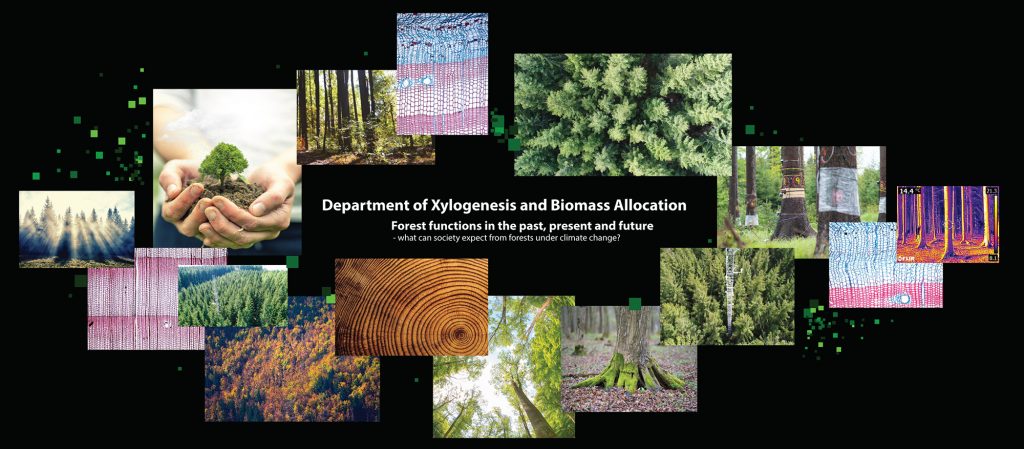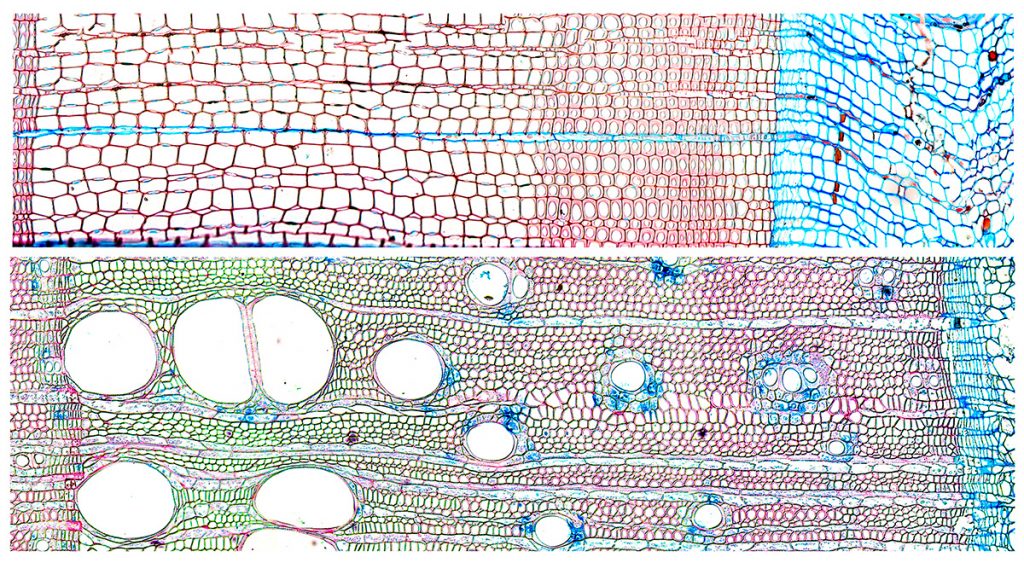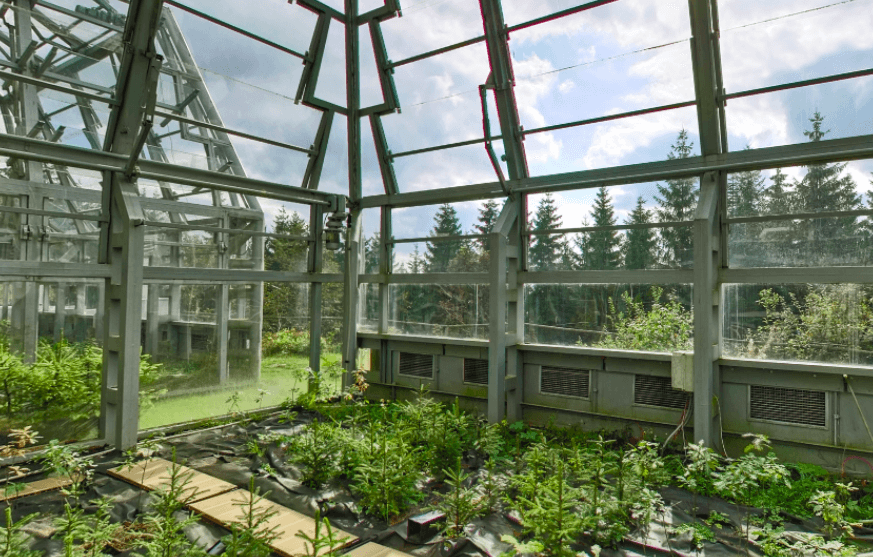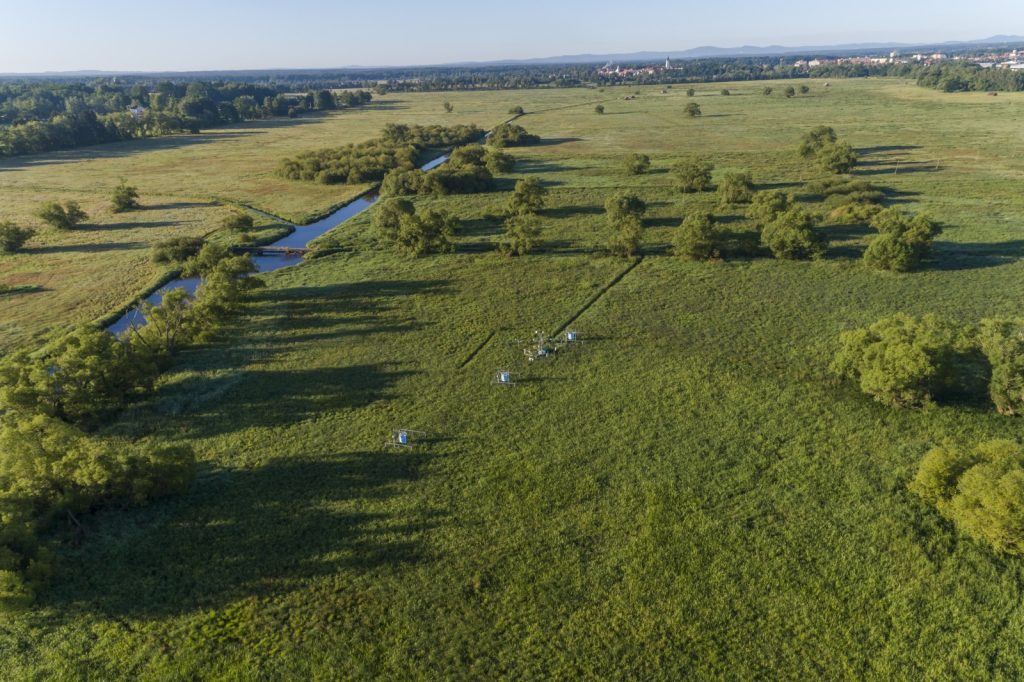prof. Dr. Ing. Petr Horáček – head
Scientists:
Ing. Marek Fajstavr, Ph.D.
Mgr. Lenka Foltýnová, Ph.D.
Ing. Růžena Janoutová, Ph.D.
Ing. Jan Krejza, Ph.D.
Mgr. Ondřej Nezval, Ph.D.
Ing. Marko Stojanović, Ph.D.
Ing. Jan Světlík, Ph.D.
Ph.D. students:
MSc. Janko Arsić
MSc. Sergei Mikhailov
Our main focus is to reveal the mechanism of environmental stress factors that influence the dynamics of wood formation and biomass (carbon) allocation in different tree species on inter- and intra-annual time scales. We investigate the ability of woody plants to acclimate to physiological drought by altering growth strategies expressed by the climate-driven primary and secondary growth.
Hence, information about tree adaptation strategies and survival in drought-prone areas is crucial for our understanding of growth strategies and tree functioning and resilience, and allow us selecting better-adapted and more resilient tree species. This is important for improving forest management in the light of climate change (eg. drought impacts) and bark beetle calamity, where especially coniferous trees are attacked, and deciduous trees are an alternative for the future.
Keywords: Wood formation, xylogenesis, dendrometers, stem radial variations, tree water deficit, carbon allocation, ecophysiology, drought, phenology, Picea abies, Fagus sylvatica, Quercus robur, Fraxinus angustifolia
Unique team profile
The department generally focuses on (1) tree growth strategies in the context of forest functional ecology under global climate change; (2) mechanism of environment (water- and biomechanical stresses) induced effect on wood formation, biomass allocation, and root turnover; (3) patterns of tree mortality and associated forest die-offs to drought accompanied by warmer temperature; and (4) evaluation of wood production decrease/increase affected by climate change.
We try to reveal (a) how drastically can the climate change affects the structure and function of trees both intra- and inter-annually; (b) what is compensatory capacity indicating the ability of trees to tolerate and/or adapt to climate change; (c) how much plasticity express anatomical and morphological traits in response to environmental stressors (hotter drought, biomechanical stress); and (d) trade-offs between hydraulic and mechanical functions – how water is involved in the biomechanical acclimation.
Five specific topics are developed in the ongoing period:
- From sap flow to wood formation – how plant hydraulics affects xylem structure and function in different tree species.
- What does the diurnal stem diameter variation tell us about the water regime, stem carbon allocation and environmental factors?
- Impacts of biomechanical stimulus on the wood formation and local sap flow pattern.
- Ecophysiological reaction of tree seedlings to stress condition under different CO2 concentrations (in glass dome).
- How can be the phenology of individual organs influenced by changing climatic conditions?
Research core methods
Secondary growth – wood (xylogenesis and morphogenesis)
The samples of xylem and phloem tissue are taken from the same sampled trees (h = 1.30 m) and from three trees in vertical profile using the Trephor tool at one week interval. The micro-cores are collected in a spiral way around the circumference of the stem (minimal mutual distance – 2 cm to avoid the sampling traumatized tissue) during growing season when the annual increment of xylem cells is completely formed. In one forming annual ring, we analyse the number of cells within cambial zone, number of early and late phloem cells, number enlarging cells, number of cells in phase of secondary wall thickening and number of fully matured (lignified) cells.
Wood is composed by several kind of cell with a specific spatial arrangement and an evolution of size of the cell and its secondary cell wall thickness over the growing season. The number and the total size of the cell illustrate the gain in stem volume while the secondary cell wall thickness reflects the biomass (carbon) acquisition of the tree. Moreover, characteristics of different kind of cells are determinant for the functions fulfilled by the wood for the tree, like sap conduction and biomechanical support.
To characterize dynamics of those processes, anatomical slides are performed from weekly wood samples. After laboratory preparation and digitalization under microscope, the developmental stage, number and the size of cell are measured. From application of models, the rate and duration of each developmental phases of each cells are obtained and could be compared to dendrometer and sap flow data.
Primary and secondary growth – stem, branch, root, needles, leaves
Stem diameter variation (SDV) is measured by automatic band and point dendrometers. Dendrometer record comprises tree growth (irreversible changes), but also tree water deficit-induced stem shrinkage which can be partitioned from the recordings. We are measuring SDV at 1.3 m above ground surface, but also in stem vertical profile to determine of stress reaction along whole stem. On the trees with vertical stem profile measurements, there are also dendrometers placed on coarse roots and coarse branches for covering the continuum roots – stem – branches.
Detection of primary growth in time is carried out based on the analysis of the phenology pictures at each sites. Also, the high frequency record of leaf area index (LAI) is used for the evaluation of leaves/needles growth. This method of LAI is based on the continuous monitoring of canopy PAR transmission with a set of fixed below-canopy PAR sensors and a reference above-canopy sensor. The samples of needles or leaves (annually) are taken for analysis of (i) leaf area to mass ratio and (ii) foliar nutrient concentration.
Primary and secondary growth – roots
Fine root length and diameter growth and other fine root traits and are measured by Minirhizotron camera method and coarse root diameter by dendrometers. Minirhizotron scans are performed twice per month and dendrometers record with 1 hour frequency .
Phenology
Based on the field visual inspection, the phenologist estimate the spring-time phenophases three times a week, summer and autumn-time phenophases twice a week during the growing season. Ground-based phenological observations are carried out according to the Methodology Guidelines for Plant Phenological Observations with internal implementation of the Czech Hydrometeorological Institute. Additionally each species is monitored by one automated phenological camera PhenoCam The images are taken daily every hour between 10 a.m. to 15 p.m.
Biometric characteristics (of seedlings)
Inventory of stem radial growth and height growth are done at the end of each growing season. Commonly, at the end of experiment, seedlings are harvested in order to compare their biometric characteristics. All above- and below plants material are subdivided into leaves, branches, stems and roots and measured for the weight in fresh and oven dried state. This is done for the purpose of whole plants leaf area and biomass estimations.
Applied outputs (strategies, methodologies, teaching activities for society)
- Background for national strategies – forest climate adaptations
Knowledge on changing climate and its specific impact on trees is very important for forestry planning and management to ensure optimal forest functioning as constrained by the growth environment. Partial aim of our department is participation and creation of concepts; by state define their direction of forestry policy in the future.
- Monitoring of drought in forests – bio indication of stress in forest
The continuous and online monitoring system is based on automatic monitoring of tree stem radius fluctuation. The monitoring system provide the information about tree water deficit, wood growth, wood carbon allocation and related indicators of drought stress at real time.
- Biomass production and carbon sequestration forecast
Current forest inventory involves forecasting methods based on statistically-valid field measurements (using statistically representative sample size). Due to future climatic conditions, the forest productivity may decrease and the ability of forest ecosystems to sequester atmospheric carbon may be reduced. It seems that current procedures overestimate large-scale forest biomass, carbon storage, and carbon sequestering rates because they fail to consider key dynamic characteristics of forests. Monitoring how a tree’s stem diameter varies over time can provide insight into intra-annual stem dynamics and improve our understanding of climate impacts on tree physiology and growth processes.
- Teaching activities (elementary and grammar schools, universities)
Participation of research team members in student lectures (MENDELU – subjects Forest Ecology, Wood Properties; Czech University of Life Sciences – subjects Strength and stiffness of wood, Theory of Elasticity of Materials) and workshops for public society, forest practitioners and government. Involvement of students (MENDELU; bachelor, diploma, Ph.D.) into scientific environment via their final thesis. Commitment of core research team members in Study programme boards (Forest Ecology, Wood Processing and Timber Technology, Forest Phytology).
Collaboration
MENDELU, Department of Wood Science and Technology (L. Praus, J. Tippner, B. Vojáčková) – bending experimentation, finite element modelling, measurements of mechanical deformation on the surface of the stem during the bending experiment; (V. Gryc, H. Vavrčík) – xylogenesis and morphogenesis
MENDELU, Department of Forest Ecology (J. Světlík, M. Belan, O. Nezval) – stem and branches growth, phenology, close cooperation on climate change investigation and its effect on forest ecosystems
MENDELU, Department of Botany (J. Čermák, J. Urban) – sap flow, tree ecophysiology
Institute of Forest Ecosystem Research (E. Cienciala) – results upscaling to national level
Forestry and Game Management Research Institute (P. Bednář) – tree canopy structure, aboveground biomass, growth trends
Czech University of Life Sciences, Department of Soil Science and Soil Protection – quantification of roots and root water uptake in soil using X-ray computed tomography
Czech University of Life Sciences, Department of Tree Physiology (I. Tomášková) – tree ecophysiology, sap-flow
INRA Grand Est-Nancy, SILVA UMR, Nancy, France (J. Dlouhá, C. Rathgeber, T.Constant) – xylogenesis dynamic and its environmental drivers, interaction biomechanics, tree size and wood properties, R programming; (M. Fournier, É. Badel) – biomechanics in ecological context, wood properties and biomechanical-hydraulic tradeoffs
BOKU, Institute of Forest Entomology, Forest Pathology and Forest Protection, Wien, Austria (S. Netherer, S. Rosner) – trees dieback, evaluation of tree vitalit
BOKU, Institute of Botany, Wien, Austria – (S. Rosner) – tree growth patterns
Norwegian Institute of Bioeconomy Research (NIBIO) (O. Janne Kjonaas) – carbon cycles in forest stands
Snow and Landscape Research (WSL) Birmensdorf, Switzerland (P. Fonti, R. Zweifel) – DENDRODROUGHT 2018 – automatic dendrometer measurements with sub-daily temporal resolution and relative metadata for the assessment of trees species responses to the extreme 2018 summer heatwave in a large part of Europe; wood formation, dendrochronology
Snow and Landscape Research (WSL) Birmensdorf, Switzerland (R.L. Peters), Ghent University, Belgium (K. Steppe) – TREEFLOW – European dataset which integrates ongoing meteorological measurements with sap flow and dendrometer measurements, as well as wood anatomical properties collected from the same individual (i.e., a tree-centered approach)
Publication
Kowalska, N.; Šigut, L.; Stojanović, M.; Fischer, M.; Kyselová, I.; Pavelka, M. Analysis of floodplain forest sensitivity to drought . Philosophical Transactions of the Royal Society B 1(1): 1-1, Article number 1, 2020
Giagli, K.; Vavrčík, H.; Fajstavr, M.; Martiník, A. Stand factors affecting the wood density of naturally regenerated young silver birch growing at the lower altitude of the Czech Republic region. Wood Research 64(6): 1011-1022, Article number 6, 2019
Merganičová, K.; Merganič, J.; Lehtonen, A.; Vacchiano, G.; Zorana Ostrogovic Sever, M.; L.D. Augustynczik, A.; Grote, R.; Kyselová, I.; Mäkelä, A.; Yousefpour, R.; Krejza, J.; Collalti, A.; Reyer, C. P. O. Forest carbon allocation modelling under climate change. Tree Physiology 40: 1-24, 2019
Schepaschenko, D.; Chave, J.; Phillips, … Krejza, J. et al. The Forest Observation System, building a global reference dataset for remote sensing of forest biomass. SCIENTIFIC DATA 6(1): 1-11, Article number 198, 2019
Fajstavr, M.; Bednářová, E.; Nezval, O.; Giagli, K.; Gryc, V.; Vavrčík, H.; Horáček, P.; Urban, J. How needle phenology indicates the changes of xylem cell formation during drought stress in Pinus sylvestris L.. Dendrochronologia 2019(56): 1125-7865, Article number 125600, 2019
Bellan, M.; Krejza, J. Estimation of newly grown needle area in Norway spruce based on simple biometrical tree parameters. AUSTRIAN JOURNAL OF FOREST SCIENCE 136(1): 1-26, Article number 1, 2019
Noyer, E.; Fournier, M.; Constant, T.; Collet, C.; Dlouhá, J. Biomechanical control of beech pole verticality ( Fagus sylvatica ) before and after thinning: theoretical modelling and ground-truth data using terrestrial LiDAR. American Journal of Botany 106(2): 1-12, 2019
Uchytilová, T.; Krejza, J.; Veselá, B.; Holub, P.; Urban, O.; Horáček, P.; Klem, K. Ultraviolet radiation modulates C:N stoichiometry and biomass allocation in Fagus sylvatica saplings cultivated under elevated CO2 concentration. Plant Physiology and Biochemistry 134: 103-112, 2019
Gazdić, M.; Reif, A.; Knežević, M.; Petrović, D.; Stojanović, M.; Dološ, K. Diversity and ecological differentiation of mixed forest in northern Montenegro (Mt. Bjelasica) with reference to European classification. Tuexenia 38: 135-154, 2018
Martiník, A.; Knott, R.; Krejza, J.; Černý, J. Biomass production of Betula pendula stands regenerated in the region of allochthonous Picea abies dieback. Silva Fennica 2018(52): Article number 9985, 2018
Fajstavr, M.; Paschová, Z.; Giagli, K.; Vavrčík, H.; Gryc, V.; Urban, J. Auxin (IAA) and soluble carbohydrate seasonal dynamics monitored during xylogenesis and phloemogenesis in Scots pine. iForest – Biogeosciences and Forestry 2018(11): 553-562, 2018
Giagli, K.; Baar, J.; Fajstavr, M.; Gryc, V.; Vavrčík, H. Tree-ring width and variation of wood density in Fraxinus excelsior L. and Quercus robur L. growing in floodplain forests. Bioresource Technology 13(1): 804-819, 2018
Stojanović, M.; Sánchez-Salguero, R.; Levanič, T.; Szatniewska, J.; Pokorný, R.; Linares, J. C. Forecasting tree growth in coppiced and high forests in the Czech Republic. The legacy of management drives the coming Quercus petraea climate responses. Forest Ecology and Management 405: 56-68, 2017
Fajstavr, M.; Giagli, K.; Vavrčík, H.; Gryc, V.; Urban, J. The effect of stem girdling on xylem and phloem formation in Scots pine. Silva Fennica 51(4): Article number 1760, 2017
Krejza, J.; Světlík, J.; Bednář, P. Allometric relationship and biomass expansion factors (BEFs) for above- and below-ground biomass prediction and stem volume estimation for ash (Fraxinus excelsior L.) and oak (Quercus robur L.). Trees: structure and function 2017(31): 1303-1316, 2017
Pietras, J.; Stojanović, M.; Knott, R.; Pokorný, R. Oak sprouts grow better than seedlings under drought stress. iForest – Biogeosciences and Forestry 9(4): 529-535, 2016
Stojanović, M.; Čater, M.; Pokorný, R. Responses in young Quercus petraea: coppices and standards under favourable and drought conditions. Dendrobiology 76: 127-136, 2016
Krejza, J.; Světlík, J.; Pokorný, R. Spatially explicit basal area growth of Norway spruce. Trees: structure and function 29(5): 1545-1558, 2015
Urban, J.; Bednářová, E.; Plichta, R.; Gryc, V.; Vavrčík, H.; Hacura, J.; Fajstavr, M.; Kučera, J. Links between phenology and ecophysiology in a European beech forest. iForest – Biogeosciences and Forestry 8: 438-447, 2014











